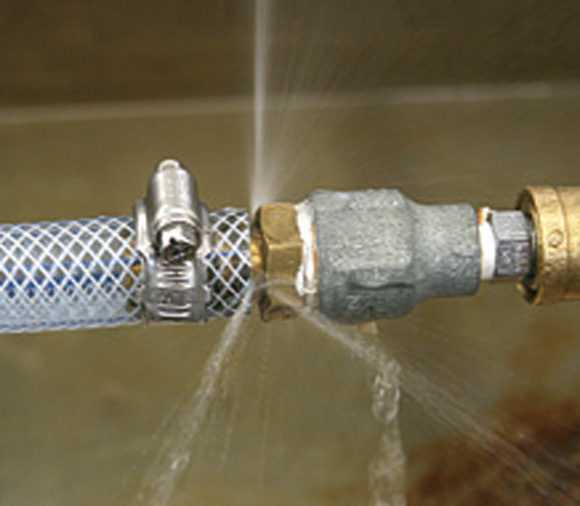Hose and Coupling Knowledge Base
If You Register to Become a Web Member, We Will Send You the Latest Information on Hoses and Coupling.
Leaks & Disconnections Due to Mismatched Couplings & Hoses

Have you ever noticed this happening?
The previous topic was stiffness, which can lead to leaks and disconnections particularly in vinyl chloride hoses. If you are using a clamp to hold a barb fitting, make sure to tighten it on a regular basis. Here, we take a look at the importance of choosing the right coupling sizes.
When connecting or selecting a 3/4 hose, a 3/4 coupling should of course be used, but what many don’t realize is that sizes can differ by manufacturer.
Have you ever bought a coupling that turned out to be too big and you had to fight to get it on? Or found that the coupling was too small and the hose was loose? We recommend using a set of calipers to measure before insertion. The table below shows how much bigger the coupling should be according to hose size.

If the coupling is too large, the fit might be all right initially, but the hose will stretch and lose integrity over time, which may eventually lead to a leak or disconnection.
On the other hand, if the coupling is too small, a leak or disconnection may happen right away.
The relationship between the hose and coupling is critical to ensure good performance.
Clamps used for barb fittings are unstable and may cause problems. To avoid such problems, Toyox has developed couplings exclusively for use with Toyox hoses. Feel free to give us a call for assistance in selecting a product or for a consultation on a problem in the workplace.
Archive
How to Cut Steel-Wire-Reinforced PVC Hose
Does Electricity Conservation Increase Condensation?
Why Do Hoses Leak & Disconnect?
Can PVC & Other Plastic Hoses Be Used for Fuel Gas & Kerosene?
How to Read Catalog Specifications, Part 4 – Are Hose Sizes Random?
How to Read Catalog Specifications, Part 3 – Minimum Bend Radius
Beware of Static Electricity on Hoses
How to Read Catalog Specifications, Part 2 – Negative Pressure+B10
About REACH, RoHS, Endocrine Disruptor & the Food Sanitation Act
How to Read Catalog Specifications, Part 1 – Use Pressure
How to Avoid Damage Caused by Ultraviolet Rays
The Dangers of Hose Condensation
Why Transparent Hoses Become Cloudy
Leaks & Disconnections Due to Mismatched Couplings & Hoses
Causes & Solutions for Leaks & Disconnections
The Benefits of the Right Hose for the Situation (2)









